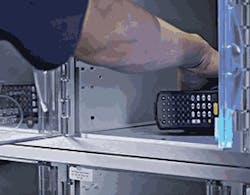Getting Smart about Inventory Replenishment
Six Sigma, lean management and ISO 9000 are just three methodologies helping companies increase process efficiency and quality in their supply chains.
Today's economy almost requires companies to deploy programs like these to stay competitive.
Some of the companies fully embracing these improvement programs still don't realize the huge levels of waste and inefficiency that can hide in operational processes, particularly when it comes to asset management and inventory replenishment. However, more and more companies are identifying these routine but important processes as areas that can be improved through automation.
High-Value Assets Represent a Significant Opportunity
Regardless of the industry, workers typically rely on high-value assets, like handheld electronic devices, to do their jobs. In fact, without these mission-critical assets, work can come to a complete standstill. These devices are shared across multiple workers —checked out at the beginning of a shift and checked back in at the end from a centrally-located tool crib to ensure the next shift has access to them.
Without proper control, this approach to asset management is inefficient and wasteful, causing a variety of issues:
Asset Issues: "Hoarding" and the outright loss of assets can occur if this process is unstaffed and devices are managed by each individual worker.
Low Productivity: Productivity suffers if someone must manage the check-in and check-out processes, or if assets are missing or not ready for the start of a shift.
Wasted Time: Time is lost by workers walking long distances to access centrally-located devices, and if supervisors must search for devices instead of focusing on more important, productive tasks.
Inaccurate Tracking: Manual tracking, usually with a pen and log book, leads to inaccurate data.
Lack of Data Insights: Offline, inaccurate data offers no real-time visibility into a device's current status or usage patterns and makes it hard to audit for regulatory compliance.
Frequent Replacements: Inconsistent recharging and maintenance leads to these high-value devices being replaced more frequently.
Companies are not typically dealing with high-value items when it comes to inventory replenishment. But the opportunity for process improvement is just as significant.
Automated Tracking of Small Items Has Big Potential
Many companies still use bin systems to house small items and supplies like washers, nuts and bolts. As a result, tracking this inventory can be just as inefficient, wasteful and expensive as traditional asset management programs:
Time-Intensive Reordering: Reordering supplies requires a manager to count the contents of each bin by hand every few days.
Poorly Spent Time: Managers and distributors conducting manual counts waste time that could be spent on more important, productive tasks.
Inaccurate Inventory: Manual counting leads to errors that, in turn, lead to critical tools and supplies being out-of-stock, which halts production.
Safety Stock Inventory: Companies carry extra "safety stock" inventory to avoid stockouts, which drags on the bottom line.
Companies can eliminate these supply chain issues from their operations and see significant results by leveraging automation to manage, track and control asset management and inventory replenishment.
Bringing Access & Control to Asset Management
Companies are automating asset management using self-serve locker systems. They are powered by cloud-based analytics and inventory management software so companies can track, manage and control high-value devices like handheld scanners, walkie-talkies and mobile tablets.
Increased Efficiency: Increases productivity by automating the check out and return process.
Fast, Efficient Check Out & Return: Reduces "walk and wait" time as assets can be deployed at the point of work throughout a facility.
Accountable Workforce: Workers check out assets using personalized ID cards or codes which increases their accountability and empowers them to access the items they need to do their job.
Increased Productivity: Managers and workers do not have to locate missing assets, allowing them to focus on more important tasks.
Automated Alerts: By tracking asset use through cloud-based software, managers can receive alerts if devices are not returned at the end of a shift, or if a device needs service.
Greater Access & Control: Managers can customize access to devices at an individual level, giving them complete control while making assets available 24/7.
Cost Decrease: Costs decrease as a result of a more productive workforce and having to replace assets less frequently.
Easy, Accurate Auditing: Ensures an accurate audit trail is available to support compliance requirements.
Inventory replenishment also benefits from the balance of access and control automation can bring to the supply chain.
Smart Bin Systems
Smart bin systems are used to organize a wide range of supplies and materials, just like traditional bin systems. However they bring these important benefits to an operation:
Automatic Low-Level Alerts: Smart bins can automatically detect low levels and send alerts to managers and distributors when pre-set minimums are reached.
Eliminating Stockouts: By eliminating stockouts, production will not be interrupted.
Increasing Cash Flow: By eliminating safety stock from inventory, there is an immediate cash flow benefit.
Increasing Productivity: With no stockouts, workers won't have unproductive, unplanned downtime while they wait for someone to make an expensive milk run to get an emergency order of supplies.
Managers Work Smarter: When managers are freed from manual bin counts, they can spend their time on more meaningful work.
More Efficient Supplier Relationships: Smart bins ensure distributors see real-time inventory levels and don't have to waste a trip just to count bins.
Businesses big and small are realizing better operational efficiencies by automating routine tasks, like asset management and inventory replenishment.
In fact, automated management of assets and inventory is well beyond the early adopter stage as businesses use it to increase productivity and reduce costs of the supply chain.
Kent Savage, founder and CEO of Apex Supply Chain Technologies, is an expert on automated dispensing and technology solutions and innovative applications of the technology. Photos provided by Apex.

